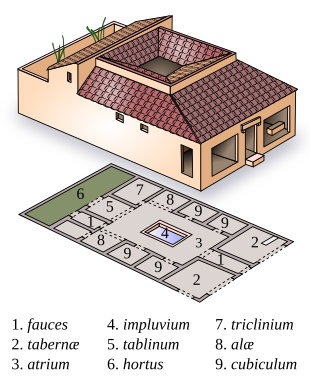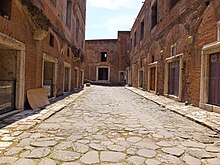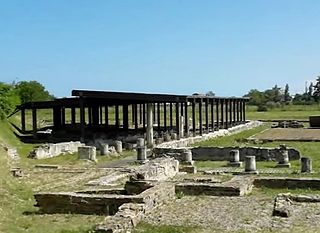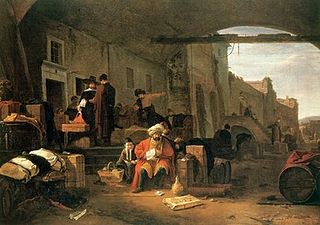
A merchant is a person who trades in commodities produced by other people, especially one who trades with foreign countries. Historically, a merchant is anyone who is involved in business or trade. Merchants have operated for as long as industry, commerce, and trade have existed. In 16th-century Europe, two different terms for merchants emerged: meerseniers referred to local traders and koopman referred to merchants who operated on a global stage, importing and exporting goods over vast distances and offering added-value services such as credit and finance.

The Roman Republic was the era of classical Roman civilization beginning with the overthrow of the Roman Kingdom and ending in 27 BC with the establishment of the Roman Empire. During this period, Rome's control expanded from the city's immediate surroundings to hegemony over the entire Mediterranean world.
Tre Taverne was a place on the ancient Appian Way, about 50 km from Rome, designed for the reception of travellers, as the name indicates.

Veii was an important ancient Etruscan city situated on the southern limits of Etruria and 16 km (9.9 mi) north-northwest of Rome, Italy. It now lies in Isola Farnese, in the comune of Rome. Many other sites associated with and in the city-state of Veii are in Formello, immediately to the north. Formello is named after the drainage channels that were first created by the Veians.
Marcus Furius Camillus is a semi-legendary Roman statesman and politician during the early Roman republic who is most famous for his capture of Veii and defence of Rome from Gallic sack after the Battle of the Allia. Modern scholars are dubious of Camillus' supposed exploits and believe many of them are wrongly attributed or otherwise wholly fictitious.

Falerii is a village in the municipality of Fabrica di Roma in the Province of Viterbo, Italy. Its name is better known for two nearby ancient cities, Falerii Veteres and Falerii Novi.

The Aequi were an Italic tribe on a stretch of the Apennine Mountains to the east of Latium in central Italy who appear in the early history of ancient Rome. After a long struggle for independence from Rome, they were defeated and substantial Roman colonies were placed on their soil. Only two inscriptions believed to be in the Aequian language remain. No more can be deduced than that the language was Italic. Otherwise, the inscriptions from the region are those of the Latin-speaking colonists in Latin. The colonial exonym documented in these inscriptions is Aequi and also Aequicoli. The manuscript variants of the classical authors present Equic-, Aequic-, Aequac-. If the form without the -coli is taken as an original, it may well also be the endonym, but to date further evidence is lacking.

The gens Furia, originally written Fusia, and sometimes found as Fouria on coins, was one of the most ancient and noble patrician houses at Rome. Its members held the highest offices of the state throughout the period of the Roman Republic. The first of the Furii to attain the consulship was Sextus Furius in 488 BC.

The Battle of the Allia was a battle fought c. 387 BC between the Senones – a Gallic tribe led by Brennus, who had invaded Northern Italy – and the Roman Republic.

Roman commerce was a major sector of the Roman economy during the later generations of the Republic and throughout most of the imperial period. Fashions and trends in historiography and in popular culture have tended to neglect the economic basis of the empire in favor of the lingua franca of Latin and the exploits of the Roman legions. The language and the legions were supported by trade and were part of its backbone. The Romans were businessmen, and the longevity of their empire was caused by their commercial trade.

The study of the Roman economy, which is, the economies of the ancient city-state of Rome and its empire during the Republican and Imperial periods remains highly speculative. There are no surviving records of business and government accounts, such as detailed reports of tax revenues, and few literary sources regarding economic activity. Instead, the study of this ancient economy is today mainly based on the surviving archeological and literary evidence that allow researchers to form conjectures based on comparisons with other more recent pre-industrial economies.
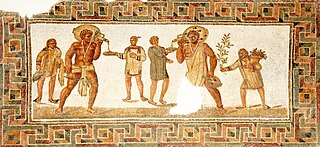
Slavery in ancient Rome played an important role in society and the economy. Unskilled or low-skill slaves labored in the fields, mines, and mills with few opportunities for advancement and little chance of freedom. Skilled and educated slaves—including artisans, chefs, domestic staff and personal attendants, entertainers, business managers, accountants and bankers, educators at all levels, secretaries and librarians, civil servants, and physicians—occupied a more privileged tier of servitude and could hope to obtain freedom through one of several well-defined paths with protections under the law. The possibility of manumission and subsequent citizenship was a distinguishing feature of Rome's system of slavery, resulting in a significant and influential number of freedpersons in Roman society.

Feronia or Lucus Feroniae was an ancient town near the present town of Fiano Romano. It is located in the plain along the Tiber river, at the foot of Mount Soracte, and was within the ancient territory of Capena. It began as a sanctuary called Lucus Feroniae in the time of Tullus Hostilius when it was located in Etruria.

A horreum was a type of public warehouse used during the ancient Roman period. Although the Latin term is often used to refer to granaries. By the end of the imperial period, the city of Rome had nearly 300 horrea to supply its demands. The biggest were enormous, even by modern standards; the Horrea Galbae contained 140 rooms on the ground floor alone, covering an area of some 225,000 square feet. They provided storage for not only the annona publica but also a great variety resources like olive oil and footstuffs. The amount of storage space available in the public horrea can be judged by the fact that when the emperor Septimius Severus died in 211 AD, he is said to have left the city's horrea stocked with enough food to supply Rome's million-strong population for seven years. Smaller horrea were a standard feature of Roman towns, cities and forts throughout the empire; well-preserved examples of military horrea have been excavated on Hadrian's Wall in England, notably at the forts of Housesteads, Corbridge and South Shields.
The Roman–Etruscan Wars, also known as the Etruscan Wars or the Etruscan–Roman Wars, were a series of wars fought between ancient Rome and the Etruscans. Information about many of the wars is limited, particularly those in the early parts of Rome's history, and in large part is known from ancient texts alone. The conquest of Etruria was completed in 265–264 BC.
The Roman–Latin wars were a series of wars fought between ancient Rome and the Latins, from the earliest stages of the history of Rome until the final subjugation of the Latins to Rome in the aftermath of the Latin War.
The Roman–Volscian wars were a series of wars fought between the Roman Republic and the Volsci, an ancient Italic people. Volscian migration into southern Latium led to conflict with that region's old inhabitants, the Latins under leadership of Rome, the region's dominant city-state. By the late 5th century BC, the Volsci were increasingly on the defensive and by the end of the Samnite Wars had been incorporated into the Roman Republic. The ancient historians devoted considerable space to Volscian wars in their accounts of the early Roman Republic, but the historical accuracy of much of this material has been questioned by modern historians.
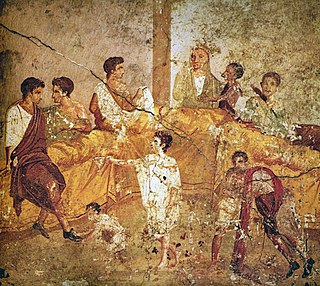
Food in ancient Rome reflects both the variety of food-stuffs available through the expanded trade networks of the Roman Empire and the traditions of conviviality from ancient Rome's earliest times, inherited in part from the Greeks and Etruscans. In contrast to the Greek symposium, which was primarily a drinking party, the equivalent social institution of the Roman convivium was focused on food. Banqueting played a major role in Rome's communal religion. Maintaining the food supply to the city of Rome had become a major political issue in the late Republic, and continued to be one of the main ways the emperor expressed his relationship to the Roman people and established his role as a benefactor. Roman food vendors and farmers' markets sold meats, fish, cheeses, produce, olive oil and spices; and pubs, bars, inns and food stalls sold prepared food.
